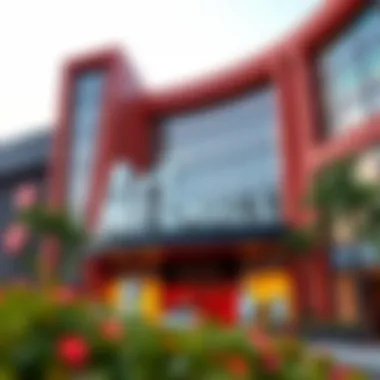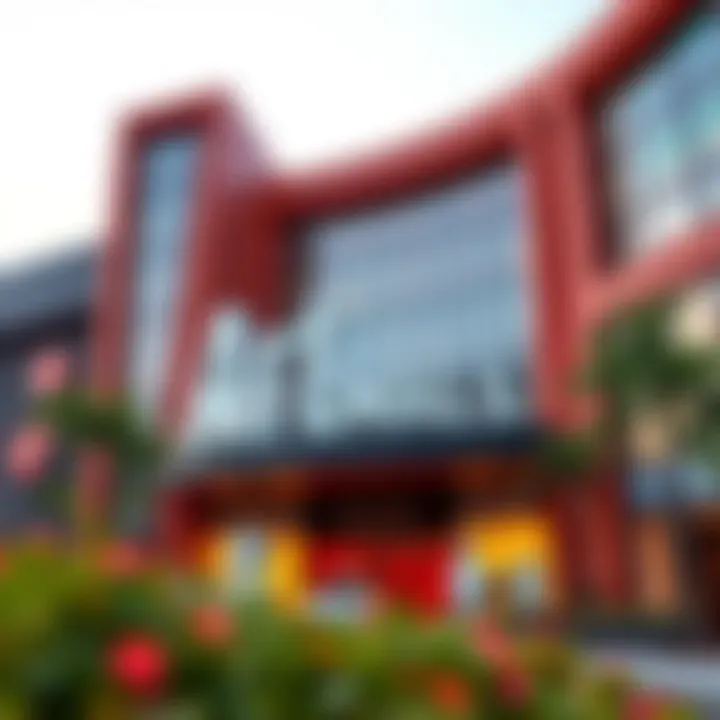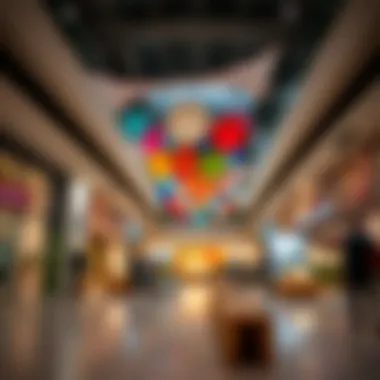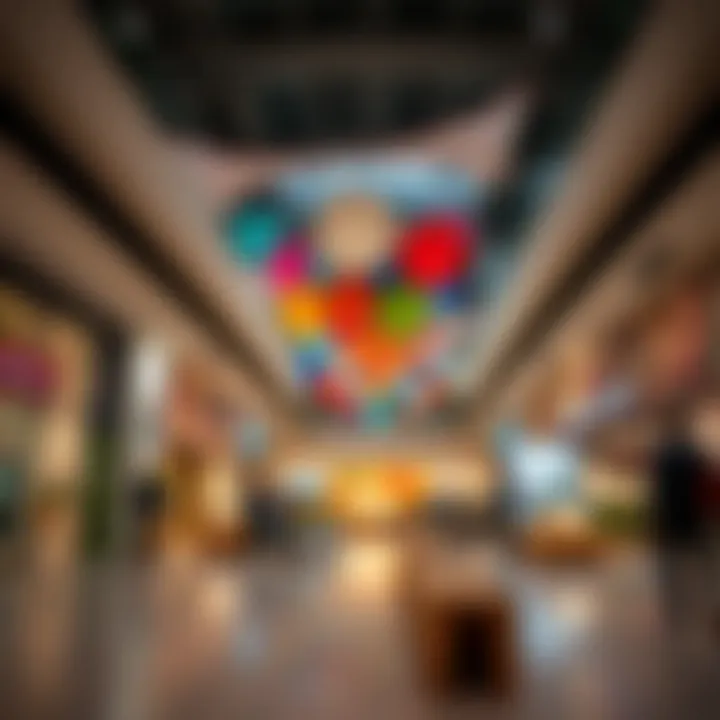Art Living Malls: Merging Aesthetics with Commerce


Intro
In recent years, the rise of art living malls has carved a unique niche within the bustling landscape of commercial real estate, especially in vibrant cities like Dubai. These innovative spaces do more than just sell products; they merge art, community, and commerce to create an ecosystem where visitors can engage with their surroundings at a deeper level. It's not only about shopping; it's about experiencing a lifestyle.
Art living malls represent a shift in how we think about retail spaces. They invite exploration, creativity, and a sense of belonging. As we delve into this intriguing phenomenon, we will examine various facets such as current property trends in Dubai, investment opportunities, and how these engaging environments influence consumer behavior and urban architecture.
The landscape is changing, and those understanding the intricate relationship between aesthetics and commerce will undoubtedly gain an edge in the real estate market. \n
Property Trends in Dubai
Emerging Neighborhoods and Hotspots
Dubai's real estate scene is constantly evolving, with art living malls becoming focal points in developing neighborhoods. Areas like Al Quoz and Dubai Design District are drawing attention for their unique blend of artistic expression and commerce. Here, vibrant murals and local installations often punctuate the commercial spaces, leading to an energizing atmosphere that keeps visitors coming back.
The emergence of these neighborhoods isn't just a random occurrence. Various factors play a role. Urban planners and developers are increasingly recognizing the importance of arts and culture as vital elements of a thriving community. These areas boast not only retail outlets but also galleries, studios, and event spaces, creating a community-centric environment that fosters creative expression.
Market Analysis and Future Predictions
Market analysis indicates that the demand for experiential shopping environments, like art living malls, is on the rise. Consumers today are not merely hunting for bargains; they seek experiences that resonate with their identities and values. This trend reflects a profound shift in consumer behavior; shoppers want to connect with brands that align with their lifestyle choices.
Real estate in Dubai stands on the cusp of transformation, especially in light of shifting demographics and cultural engagement. The future looks bright for art living malls, with predicted growth not only in foot traffic but also in overall investment opportunities within these spaces. As the city continues to redefine luxury and lifestyle, there's no doubt these malls will play a critical role in shaping Dubai’s architectural identity and economic landscape.
"Art living malls embody the essence of modern commerce; they create a living canvas where community and creativity thrive side by side."
Investment Opportunities
High-ROI Property Types
Investing in art living malls can yield significantly high returns. Property types that are customized to blend retail and art spaces cater to an affluent clientele looking for unique experiences. Investors should consider mixed-use developments, which combine residential, retail, and cultural spaces.
Such investments often provide:
- Increased foot traffic
- Diverse income streams from various tenancy types
- Amplified property values through community engagement
Financing and Mortgage Options
Navigating the financing landscape for art living mall investments requires a clear understanding of available options. Traditional mortgage routes exist, but there are also boutique lenders willing to finance unique commercial spaces. Engaging with financial advisors who specialize in commercial real estate can unveil potential pathways suited to art living malls.
Exploring innovative financing methods such as crowdfunding or participation in real estate investment trusts (REITs) further diversifies the funding options available to potential investors. Keeping abreast of government incentives for art and culture can also provide leverage when seeking financial backing.
For those looking to venture into this realm, the fusion of aesthetics and commerce presents an avenue ripe with potential. The future of retail is here, and it's creative, vibrant, and distinctly community-focused.
Understanding Art Living Malls
In an era where traditional retail is grappling with a whirlwind of change, understanding art living malls has become essential for investors, developers, and planners. These innovative spaces blur the lines between commerce, art, and community. They are more than just shopping centers; they act as cultural hubs that encourage social interaction while providing a unique shopping experience. This dual purpose amplifies their significance in an urban environment, particularly in dynamic markets like Dubai's.
Art living malls offer a blend of visual stimulation and consumer convenience. Consumers today seek more than mere products—they crave experiences. By integrating art into commercial spaces, these malls not only enhance aesthetic appeal but also foster emotional connections with visitors. From interactive installations to murals, art encourages foot traffic and engagement, leading to longer visits and higher spending. Furthermore, as lifestyle centers, these malls drive community bonding, making them attractive to both dwellers and tourists alike.
Definition and Origins
Art living malls, at their core, refer to shopping environments that seamlessly integrate artistic expression with retail and community functions. This concept emerged in the late 20th century as a response to the growing demand for experiential and lifestyle-oriented shopping. The origins can be traced back to mixed-use developments in urban centers that sought to merge leisure, culture, and retail into a singular experience. Notably, locations like the Westfield Sydney or the Aventura Mall in Florida have paved the way for what art living malls represent today.
Cultural Significance
The cultural significance of art living malls extends far beyond retail. These spaces serve as reflection points of urban identity. They often showcase local artists, celebrate cultural heritage, and create a platform for community dialogue. For instance, the use of indigenous art styles or themes in design often highlights the locality, echoing the identity of the neighborhood. This enriches the cultural fabric of the area, making art living malls central to community development.
Additionally, the trend encourages collaboration between artists, retailers, and local organizations, fostering a creative ecosystem that benefits everyone involved. An art living mall can act like a canvas, where every brush stroke—be it an installation or a pop-up shop—adds layers to the storytelling of the space.
Evolution of Retail Spaces
The evolution of retail spaces is a tale of adaptation and transformation. With the advent of e-commerce, traditional shopping methods saw a steep decline. However, art living malls emerged as a counter-narrative to this trend, offering not just products but unforgettable experiences. Today's shoppers want to touch, feel, and immerse themselves in the purchasing process. In essence, the evolution is characterized by a shift from transactional spaces to holistic environments where shopping intertwines with leisure and culture.
Prominent examples include the likes of The Mall of America, which began as a simple shopping center but has evolved into a true experience destination, featuring entertainment options alongside retail. This suggests a future where shopping could become an art form in itself, encouraging more than just consumerism but also social engagement and cultural appreciation.


Art living malls are redefining the way we perceive retail. Recognizing their importance allows stakeholders to harness potential opportunities, paving the way for innovative approaches to urban retail development that align with contemporary consumer expectations.
Architecture of Art Living Malls
The architecture of art living malls represents a remarkable fusion of design, functionality, and cultural expression. These spaces not only serve as shopping destinations but also as community hubs and showcases of artistic innovation. With the rise of experiential consumerism, understanding the architectural elements of these malls is paramount for investors, developers, and urban planners alike.
Design Principles
When it comes to designing art living malls, several core principles guide architects and designers. One fundamental aspect is the concept of openness. Many successful art living malls feature large, open spaces that encourage foot traffic and interaction. Rather than feeling confined, shoppers are invited to explore different areas, creating an engaging and bustling atmosphere.
- Light and Airflow: Natural lighting plays a crucial role. Skylights and large windows allow daylight to fill the spaces, lifting the mood and drawing people in. This openness isn't only aesthetic; it's essential for enhancing shopper experiences.
- Navigational Ease: Incorporating intuitive pathways and clear signage allows for seamless circulation within the mall. It is imperative that visitors can easily navigate through retail spaces, art installations, and communal areas.
- Flexible Spaces: Design should prioritize adaptability. Multi-purpose areas can host pop-up events, exhibitions, or leisure activities, allowing mall management to keep the environment dynamic and fresh.
Integration of Art Installations
Art installations are the beating heart of art living malls, serving to cultivate a unique shopping experience and reflect local culture. Rather than treating art as an afterthought, these malls integrate it throughout their design in imaginative ways.
- Site-Specific Installations: Artists often collaborate with architects to create installations that are embedded into the architecture itself. This turns walls, walkways, and even ceilings into canvases.
- Interactive Art: Some installations encourage audience participation, which transforms the passive act of shopping into an interactive experience. For instance, sculptures that react to touch or digital art displays that change according to the time of day engage visitors on multiple levels.
- Local Artistry: Showcasing local artists fosters a sense of community and belonging. Art living malls often host rotating exhibitions or permanent displays highlighting work from regional talent. This not only beautifies the space but also supports local economies.
"Art in public spaces does not only inform the architecture but can transform its very essence."
Sustainability Considerations
Sustainable design is increasingly critical in the construction and operation of art living malls. In a world grappling with climate change, these spaces have begun to adopt eco-friendly practices that benefit both the environment and the local community.
- Eco-Friendly Materials: Using materials that are sustainably sourced minimizes the carbon footprint. For example, reclaimed wood, recycled steel, and low-VOC paints contribute to healthier indoor air quality and environmental sustainability.
- Energy Efficiency: Advanced heating, ventilation, and air conditioning (HVAC) systems, along with solar panels, can significantly reduce energy consumption. Many malls are now leveraging technology to ensure energy efficiency without sacrificing comfort.
- Water Conservation: Integrating rainwater harvesting systems and using drought-resistant landscaping are other effective solutions. These initiatives not only conserve water but also reduce municipal resource dependency.
The thoughtful integration of these design principles, art installations, and sustainability efforts exemplifies how architecture in art living malls is not just about aesthetic appeal. It shapes consumer behavior, community identity, and economic viability, making it a critical aspect of modern retail environments.
Economic Impact of Art Living Malls
The rise of art living malls signifies not just a trend in consumer behavior but a profound shift in how urban environments function economically. They foster a unique blend of commerce and art, generating new revenue streams while shaping local economies. It’s like bringing together the best of both worlds—where aesthetics meet financial viability, creating spaces that are both visually compelling and economically sound. Let's drill down into the various facets of economic impact that art living malls have on their surroundings.
Revenue Generation Models
Art living malls utilize diverse revenue generation models that go beyond traditional retailing. They capitalize on the merging of commerce and culture by integrating various revenue streams, including:
- Retail Sales: The backbone of any mall. Stores selling both luxury items and artisanal goods attract a diverse demographic.
- Event Spaces: Hosting art exhibitions, performances, and community events creates additional income, transforming the mall into a vibrant cultural hub.
- Membership Programs: By offering exclusive benefits, malls can build a loyal customer base, thus ensuring a steady income.
- Collaborative Partnerships: Collaborations with artists or local businesses can result in unique installations or pop-up shops, drawing in traffic and increasing sales.
These models are not just about money. They redefine how consumers interact with shopping spaces. When visitors see art and commerce intertwined, they are more likely to linger, shop, and return.
Attracting New Demographics
Art living malls are designed to captivate a broad spectrum of demographics. They have the potential to draw in not only shoppers but also art enthusiasts, families, and even tourists. Here are key aspects of how they attract these new visitors:
- Cultural Programming: By offering workshops, classes, or talks, these malls engage with the community and keep diverse groups interested.
- Family-Centric Spaces: Children’s play areas or interactive exhibits attract families, shifting the focus from mere shopping to experiential learning.
- Social Spaces: Cafes, lounges, and art installations provide spots for social interaction, appealing to friends and groups seeking a social outing.
- Digital Influence: Many malls are leveraging social media to create buzz and engage younger audiences, drawing in those who might typically prefer online shopping over physical stores.
It's fascinating to witness how these elements transform a mall into a community focal point. They become places where people meet, share experiences, and spend money—keeping the economic wheel turning.
Case Studies of Success
To understand the economic impact thoroughly, we can look at specific examples of successful art living malls. These case studies illuminate the potential of such spaces:
- The Dubai Mall: Known for its luxury retail shops and art installations, it has played a significant role in the Dubai economy, attracting millions of visitors from around the world. Its model of combining high-end boutiques with art exhibitions serves as a blueprint for similar developments.
- K11 Art Mall in Hong Kong: This space mixes shopping with art appreciation, featuring local artists' work. The distinct approach resonates with consumers looking for unique experiences, boosting foot traffic and retail numbers.
- Pavilion Kuala Lumpur: With a strategic focus on lifestyle and art, Pavilion not only reports impressive financial performance but often ranks high in terms of consumer satisfaction due to its aesthetically pleasing environment.
These case studies illustrate not just success but also a roadmap for potential investors or developers looking to delve into this market. They emphasize the effectiveness of merging art with commerce to build economically robust environments.
"The rise of art living malls is indicative of a larger movement in retail that embraces creativity and community, which ultimately drives economic success."
In closing, as we dissect the economic impact of art living malls, it becomes evident that they are more than mere shopping venues. They are multi-faceted spaces intertwining culture, community, and commerce, offering rich opportunities for growth and innovation in today’s urban landscape.
Consumer Behavior in Art Living Malls
Understanding consumer behavior in art living malls not only enhances the shopping experience but also sheds light on broader commercial trends. These malls are more than spaces to purchase goods; they are dynamic environments that shape how and why people engage with brands and culture. This section dives into how these malls cater to changing preferences, prioritize experiential shopping, and reflect local identity.
Shifting Preferences


Consumer preferences have undergone seismic shifts in the last decade, particularly in urban settings. The classic paradigm of shopping being limited to transactional encounters is fading fast. Today’s shoppers often seek a deeper connection with the spaces they enter. Art living malls respond to this shift by curating environments that encourage discovery and interaction.
For instance, consider how visitors are often drawn to pop-up exhibitions or artisan markets within these malls. These setups not only showcase local talent but also foster a sense of community, making the shopping experience feel less like a chore and more like a social outing. Shoppers are more inclined to spend their time and money in places that resonate with their values—a trend that many developers are keen to tap into.
- Local Flavor: Consumers show growing interest toward supporting local artists and businesses. This trend helps shape a mall's unique personality, making it more attractive to visitors.
- Experiential Focus: With experiences becoming the currency of engagement, malls are increasingly transforming into venues offering workshops, art classes, or even live performances.
The result is a shift in how brands communicate and interact with consumers. Shoppers no longer just buy products; they buy into experiences, stories, and emotions that these spaces cultivate.
The Role of Experience
In the bustling corridors within art living malls, experience reigns supreme. Unlike traditional retail settings that prioritize inventory over engagement, art living malls focus on the sensory journey of their visitors. Everything from the layout and design to the sounds and smells aims to invoke emotions and create memorable moments.
Visitors may find themselves drawn into interactive installations or guided through curated art displays, blurring the lines between retail and artistry. The goal is to nurture a deeper emotional connection with both the space and the brands involved.
- Emotional Connection: The integration of art within the retail environment can spark conversations and memories, enhancing the shopper's journey.
- Social Engagement: Experiences that encourage collaboration—be it through workshops or shared dining spaces—help generate a sense of belonging.
Art living malls epitomize this approach by inviting customers to not only purchase but also participate. Experiences matter, transforming apathetic buyers into loyal patrons who feel part of something bigger than themselves.
Art and Local Identity
Art living malls stand as a mirror reflecting the culture and diversity of their local communities. They can signal where a city is heading, capturing the essence of regional artistry while providing a platform for emerging local talent. This connection to local identity shapes the consumer's motivations as they become ambassadors of their culture through their shopping choices.
For example, collaborating with local artists for exhibitions can deepen consumer ties to the mall as they see pieces that resonate with their community’s narrative. This integration not only contributes to the mall's aesthetic but also plays a vital role in fostering civic pride.
- Cultural Relevance: By showcasing local creativity, art living malls become a valuable resource in promoting cultural narratives and diversity.
- Community Support: Consumers feel empowered when they support local artists, knowing that their purchases contribute to community livelihoods.
Overall, art living malls seamlessly intertwine commerce with cultural identity, allowing consumers to feel that they are participating in a dialogue—one that reflects both personal and collective values. The experience doesn’t end at the cash register; rather, it continues to evolve, shaped by the stories and identities of the shoppers who walk through the doors.
Challenges and Criticisms
The emergence of art living malls has not been without its share of challenges. While they aim to enrich community life and enhance the shopping experience, reactions against them call into question the very ideals they represent. This section explores three main criticisms often directed toward these unique spaces, including the commercialization of art itself, gentrification and displacement of local communities, and the balancing act between aesthetics and practical functionality.
Commercialization of Art
In a world where everything seems to have a price tag, the commercialization of art steers a ship laden with controversy. Some critics argue that art living malls reduce artistic expression to mere commodities, stripping away the intrinsic value that art holds. While the inclusion of art in retail spaces can draw more visitors and generate revenue, the slippery slope towards treating art merely as a sales tactic poses significant ethical questions. For instance, when works are curated for the sake of pleasing a consumer’s eye rather than expressing a deeper message, can one still consider that art?
Moreover, the fine line between fostering innovation and exploiting creativity becomes blurred. Local artists may find it hard to thrive in an environment dominated by commercial interests. Their creations, now seen as vehicles for economic gain, face risks of dilution. It’s essential to consider how local artists are represented and compensated within these commercial frameworks.
“When art becomes a tool for commerce, we must ask ourselves: is the artist still the voice or merely a vendor in a market?”
Gentrification and Displacement
The influx of art living malls often coincides with broader trends in gentrification, which raises red flags for local communities. As these dynamic spaces attract a wealthier clientele, the surrounding neighborhoods can suffer drastic changes. Small businesses that once catered to local tastes may be unable to compete with upscale shops and high-end establishments. This situation can lead to the displacement of long-term residents who can no longer afford the rising rents.
Gentrification’s impact on communities can be profound. When longstanding cultural identities are erased in the name of development, the sense of local belonging diminishes. In places like Dubai, where diverse cultures intermingle, it is vital to preserve the distinctive character of neighborhoods even as new developments spring up. It demands a conversation around responsible practices for community integration that honors existing residents while promoting new growth.
Balancing Aesthetics and Functionality
Another challenge art living malls face is achieving a harmonious balance between aesthetics and functionality. While the aim might be to create visually stunning environments, these beautiful facades can sometimes come at a cost to practical use.
For example, winding staircases and open-concept spaces might look impressive in design blueprints, but they often fail to account for foot traffic patterns or the needs of differently-abled individuals. How do we create spaces where beauty does not overshadow usability? Designers must wrestle with questions of accessibility and practicality while still appealing to the artistic nature that occupies these malls.
Investors and developers should take heed of how a space feels as much as how it looks. It's not just about giving a wow factor but ensuring that every visitor can navigate the space comfortably.
Art living malls hold great potential to redefine urban experiences. However, acknowledging and addressing these challenges is crucial in shaping spaces that not only dazzle but also serve and uplift the communities they inhabit.
Art Living Malls in Dubai
Art living malls represent a transformative force in Dubai’s commercial landscape, merging aesthetics with functionality. These dynamic spaces resonate with the vibrancy of the city, fostering not only commerce but also cultural exchange and community engagement. As Dubai continues its ascent on the global stage, the significance of art living malls becomes increasingly prominent. From their architectural splendor to the diverse experiences they offer, these malls stand as landmarks that reflect the evolving identity of the city.
Overview of Key Locations
When one thinks of art living malls in Dubai, several prominent sites immediately come to mind. Locations such as The Dubai Mall, Mall of the Emirates, and City Walk exemplify the essence of this new retail paradigm.


- The Dubai Mall houses an impressive collection of art installations alongside its retail offerings. The mesmerizing Dubai Fountain and the intricate design of the mall itself elevate customer experiences.
- Mall of the Emirates is not just a shopping haven but also features the famed indoor ski slope, Ski Dubai, which enhances the visitor experience with its unique blend of art and innovation.
- City Walk integrates public art displays with boutique stores, making it a favorite for both locals and tourists eager to enjoy a vibrant shopping experience along with artistic engagement.
Each location brings together an array of activities, providing platforms for art exhibitions, performances, and seasonal events, making them lively cultural hubs that go beyond mere shopping.
Influence on Local Real Estate Market
The growth of art living malls has significantly impacted Dubai’s real estate market. As these malls emerge, they often catalyze further investment in surrounding areas, driving demand for residential and commercial properties. Investors have noted the value of proximity to vibrant retail spaces as a key selling point for residential developments.
- Increased Demand: Areas near art living malls are witnessing a surge in interest, leading to rising property values.
- Commercial Growth: Businesses gravitate toward these high-traffic areas, contributing to the local economy.
- Lifestyle Development: Art living malls promote a lifestyle that integrates residential, leisure, and shopping experiences.
As a result, the real estate landscape is shifting, with developers prioritizing mixed-use projects that incorporate elements of art and culture similar to those found in these malls.
Future Developments in Dubai
The future of art living malls in Dubai is poised for exciting developments. With ongoing advancements in technology and design, upcoming malls will likely continue to push the envelope of what these spaces can offer. Features to anticipate include:
- Smart Technologies: Integrating smart systems for enhanced visitor experiences, such as interactive art displays and mobile shopping applications.
- Eco-friendly Designs: Future malls may focus more on sustainability, using green technologies to reduce their environmental footprint and promote eco-conscious living.
- Cultural Collaborations: Partnerships with local artists and institutions will likely expand, ensuring that these spaces continually reflect the local culture while innovating.
"Art living malls in Dubai are where commerce meets culture, redefining retail in a city known for its bold ambitions and creativity."
For additional insights on the city's vibrant real estate market, you can check out resources from Dubai Land Department and The World Bank.
Each of these elements establishes art living malls as critical players in the enhancing narrative of Dubai’s urban identity.
The Future of Art Living Malls
The future landscape of art living malls is poised to evolve dramatically as they blend aesthetics, commerce, and community in unprecedented ways. These spaces encapsulate the very essence of modern retail, thriving not just as places to shop but as multi-dimensional venues for experience and engagement. The integration of art, culture, and commerce points toward a transformative horizon that beckons investors, developers, and city planners.
As we look ahead, it becomes clear that the potential for growth is vast—all eyes should be on how art living malls adapt to changing consumer behaviors and technological advancements. Understanding these shifts provides a strategic advantage for stakeholders keen on maximizing their investments while also contributing to the cultural fabric of urban environments.
Emerging Trends
In recent years, the trend of combining artistic expression with shopping spaces has gained momentum. More than ever, consumers demand a unique experience that transcends traditional retail. One particularly notable trend is the increased focus on local culture. Perhaps local artisans and artists are welcomed to create interactive displays, ensuring that each mall resonates with the community it serves. As global consciousness rises, sustainability in design is becoming paramount. This means art living malls will likely incorporate eco-friendly practices, showcasing a commitment to not only aesthetics but also environmental responsibility.
Moreover, the rise of hybrid spaces—where retail intertwines with art galleries, performance spaces, and even community forums—is on the horizon. Customers will not just march down aisles but wander through galleries that showcase regional and global talent. This shift is sparking a renaissance in how we perceive commercial spaces.
Technological Innovations
Advancements in technology are likely to play a significant role in shaping the future of art living malls. For instance, augmented reality (AR) and virtual reality (VR) may extend beyond mere applications, creating immersive shopping experiences where customers can visualize art installations within their own homes before purchasing. Imagine walking through a mall where digital displays beam personalized art recommendations directly to you based on your past interests.
Moreover, the use of data analytics is becoming prevalent. Retailers are increasingly harnessing data to understand customer preferences better. These insights not only enhance the shopping experience but also help optimize store layouts. With the world heading towards greater digital integration, the implementation of mobile applications to connect artists, retailers, and consumers can transform how interactions unfold within these malls.
Predictions for Growth
The trajectory for art living malls points toward a burgeoning market that marries commerce with culture. As urbanization continues to accelerate, and as cities prioritize experiential spaces, these malls are likely to proliferate in urban areas across the globe.
Growth predictions are substantial, underlining the necessity for stakeholders to act swiftly. By 2030, art living malls could see foot traffic increasing by upwards of 30%, driven by demand for experiential shopping environments rather than mere transactional venues. Moreover, as cities around the globe grapple with evolving consumer demands, art living malls could become crucial in revitalizing underdeveloped areas.
"The art living mall isn’t just a shopping complex; it's a canvas for community interaction and creative expression."
This investment in the blending of art with commerce is not without risks. However, those willing to embrace innovation, keep an ear to the ground for emerging trends, and remain adaptable will not only thrive but also redefine the urban landscape. The future of art living malls is exciting—a symphony of creativity and commerce waiting to unfold.
Finale
The evolution of art living malls signifies more than just a shift in retail; it’s a reflection of societal changes and evolving consumer preferences. As such, understanding this concept is crucial for anyone interested in the intersection of aesthetics and commerce. Through this article, we have explored how art living malls not only provide a unique shopping experience but also serve as cultural hubs that facilitate increased community engagement and identity.
Summary of Key Insights
In synthesizing the various elements discussed, several insights stand out:
- Cultural Significance: Art living malls serve as an expression of local culture, often featuring works by regional artists that resonate with community values.
- Architectural Design: The architecture of these malls prioritizes both aesthetic appeal and functionality, creating environments that attract foot traffic while also being conducive to social interactions.
- Economic Benefits: Through innovative revenue models, art living malls can significantly boost local economies, encouraging new business opportunities and attracting diverse demographics.
- Consumer Behavior: Today's consumers demand more than just products; they seek holistic experiences that blend shopping, art, and leisure, making art living malls a perfect answer to this need.
In a world where experiences often outweigh material possessions, art living malls emerge as beacons of community connection and cultural richness.
Final Thoughts on Art Living Malls
Reflecting on the findings within this article, it becomes clear that art living malls are not just places to shop; they serve to enrich communities. As they evolve, developers and planners must embrace sustainability and inclusivity within their designs.
The future trajectory of these spaces appears promising, with the potential for innovation in technology and aesthetics that can further enhance their appeal. Understanding the implications of this trend is invaluable for investors, agents, and developers looking to navigate the complexities of the evolving real estate landscape in urban areas like Dubai.
Ultimately, art living malls embody a fusion of art and commerce that resonates with modern society’s desire for meaningful experiences. It is a trend worth watching as cities continue to evolve, and it’s likely to shape the future of urban shopping in profound ways.















